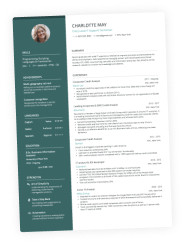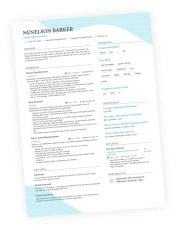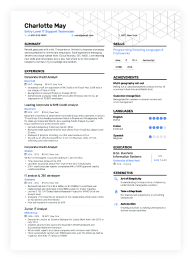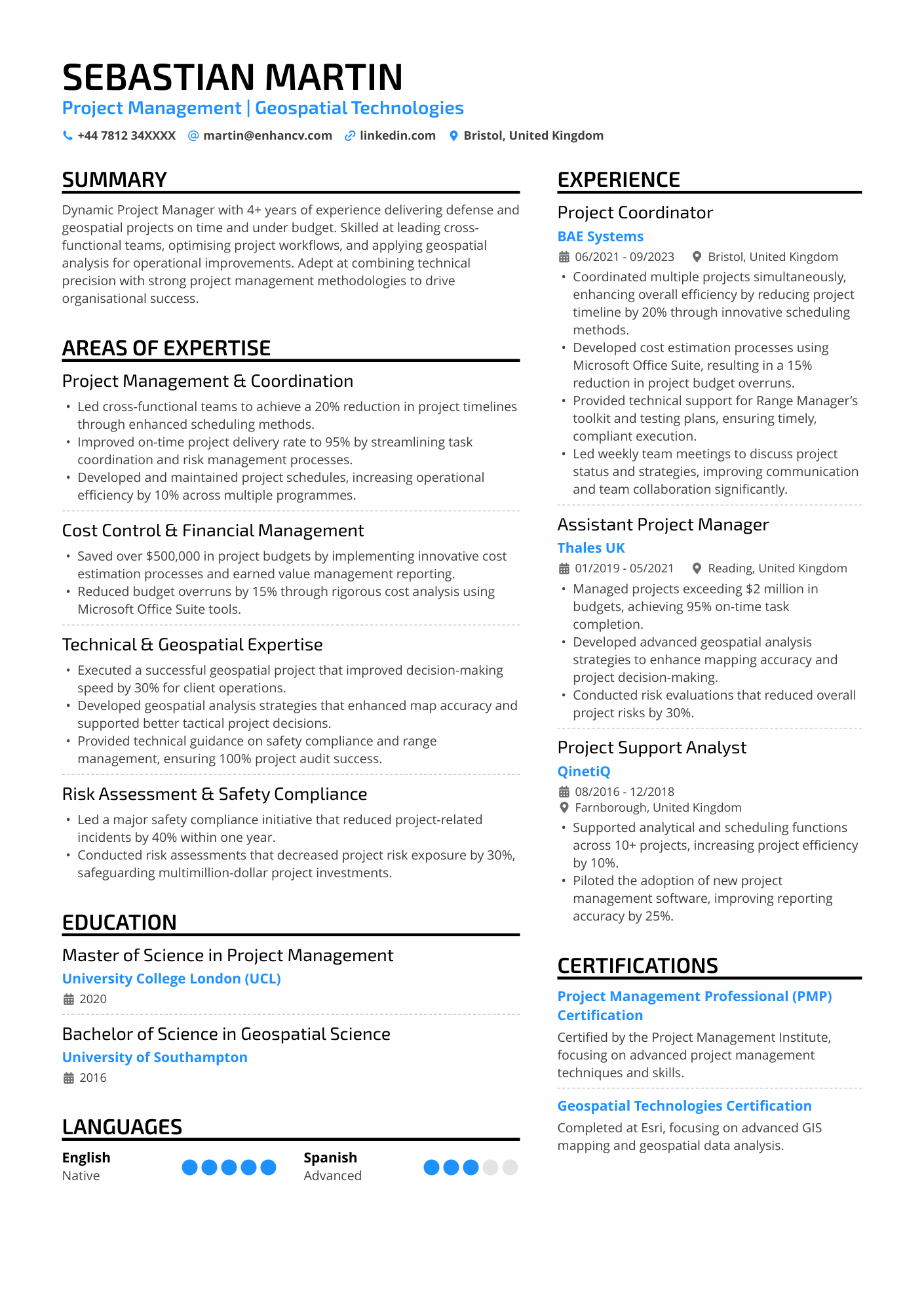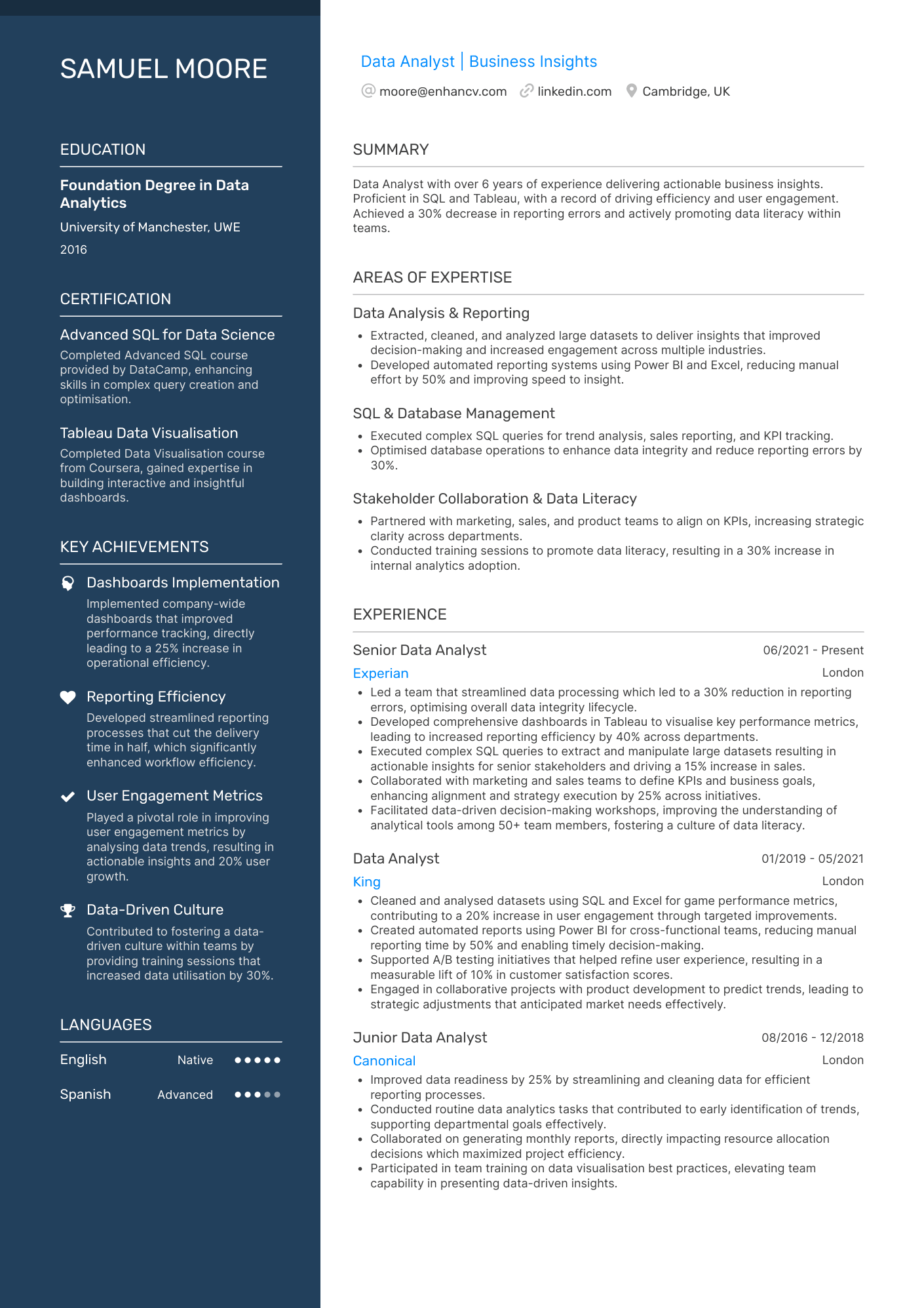A combination CV, sometimes called a hybrid CV, blends the best of two worlds—it highlights your most important skills while still showcasing your work history in reverse chronological order. It’s a great choice for professionals who want to show both what they can do and where they’ve done it.
In this guide, we'll walk you through how to create a strong combination CV, step-by-step. You'll also find real examples and Enhancv's combination CV templates to get you started. Whether you're switching careers or moving up, we’ll help you present your skills and work history with confidence.

Key takeaways
- A combination CV blends a strong skills section with a reverse-chronological work history, offering the best of both worlds.
- This format is ideal for mid-level professionals, career changers, and job seekers in the IT field.
- Enhancv’s CV templates simplify the design process so you can focus on tailoring your content for maximum impact.
- To make the most of this format, lead with grouped skills supported by measurable results, and back them up with concise, relevant experience.
- Avoid common pitfalls like repeating information, listing skills without context, or using cluttered layouts—clarity and structure are key.
Before we dive into the nuts and bolts of crafting your own, let’s break down exactly what a combination—or should we say, hybrid—CV really is and why it might be the perfect fit for your next career move.
What is a combination CV format?
A combination CV is a format that highlights both your most valuable skills and your employment history. It blends the structure of a skills-based CV with the familiar, reverse-chronological timeline employers expect—hence the name "combination," sometimes also called a hybrid CV.
In most cases, your CV opens with a thorough skills section, allowing you to group your abilities into clear areas of expertise before diving into your work experience.
Some combination CVs even describe career history by linking each role to specific skills, making it easier for hiring managers to see the full picture at a glance.
Here’s an example of a combination CV made with Enhancv’s AI CV Builder:
In a combination CV:
- Key skills and core competencies are listed at the top, giving recruiters a quick snapshot of your strengths.
- Work experience follows in reverse chronological order, showing the trajectory of your career.
- Education, certifications, and additional sections come after, rounding out your professional profile.
Now that you’ve seen how a combination CV brings together strengths and experience, it’s worth understanding how it stacks up against the other two main CV structures.
Combination CV vs reverse chronological and skills-based formats
Each of the three CV formats has its benefits—and choosing the right one can make all the difference in how your story lands with recruiters.
Here’s how they compare:
Which CV format should you choose? A side-by-side breakdown
| Format | Main focus | Layout | Downsides | Best for |
|---|---|---|---|---|
| Reverse chronological | Work history | Job titles and dates are listed from most recent to oldest, often with bullet-pointed achievements. | Can highlight employment gaps or limited experience; less flexible for unconventional paths. | Professionals with a steady, upward career trajectory. |
| Skill-based/Functional | Skills and strengths | Skills are grouped into categories, often without detailed work history. | Can raise red flags with recruiters; lacks context if skills aren't backed by quantifiable results. | Career changers, creatives, recent graduates, or those with non-linear paths. |
| Combination/Hybrid | Skills first, then experience | Opens with key skills grouped by area of expertise, followed by chronological work history. | Can become dense if not well-organised; may require more tailoring for each role. | Mid-level professionals, career changers, tech leads. |

PRO TIP
It’s a common misconception that only certain CV formats can pass applicant tracking systems (ATS). In reality, any format—reverse chronological, functional, or hybrid—can be ATS-friendly if done right. What matters most is how well you integrate job description keywords and whether your design is machine-readable (think clean fonts, standard headings, no text in images).
That said, some industries like academia or law may expect more traditional layouts, so always check the application requirements in advance.
Outside of those exceptions, focus less on the format and more on clarity, structure, and relevance.
In a nutshell, the reverse chronological CV is the default that most recruiters expect. It’s clean, linear, and great when you have a consistent employment history.
The skills-based CV puts the spotlight on skills instead of job titles. It's helpful when your experience is limited or unconventional, but it can be a bit risky with applicant tracking systems, which often rely on clear job timelines.
The combination CV blends the two. It lets you lead with your strengths—grouped by expertise—and still provides a clear employment timeline. Done right, it’s both human- and ATS-friendly.
Is your CV good enough?
Drop your CV here or choose a file. PDF & DOCX only. Max 2MB file size.
More pros and cons of the hybrid (combination) CV
Like any format, the combination CV comes with its strengths and trade-offs. If you're considering it, it's worth understanding where it shines and where it might require more finesse.
Below, we've laid out the key advantages and potential drawbacks to help you decide if this format fits your goals and experience level.
Pros
- Spotlights your strengths: This format puts your skills and achievements right at the top of your CV—exactly where a recruiter’s eye naturally lands. It’s ideal for showcasing what you’re truly great at, especially if job titles alone don’t tell the full story.
- Flexible storytelling: A combination CV gives you more control over the narrative of your career. You can group skills into themes, spotlight transferable abilities, and smooth over career pivots in a way that still feels structured and professional.
- Good for ATS parsing: Despite what you might’ve heard, combination CVs work well with ATS—if they’re clearly structured. They give you room to include keyword-rich skills while still listing job titles and dates in a way most systems can read.
Cons
- Can get crowded: Because this format tries to do more—highlight skills and tell your work history—it can get dense if not carefully formatted. White space, section headings, and clean design are essential.
- Not ideal for minimal experience: If you’re a recent graduate or have little employment history, you might struggle to build out both the skills and experience sections meaningfully. In those cases, a skills-based CV might serve you better.
- Requires strong organisation: A cluttered hybrid CV can confuse both ATS software and human readers. Clear sectioning, logical grouping of skills, and visual hierarchy are key to making it work.
With all that said, one of the biggest challenges job seekers face isn't writing a combination CV—it’s realising that this format is even an option.
If you're wondering whether a hybrid CV is right for you, here are a few scenarios where it might be the perfect fit.
When should you use a combination CV?
When it’s the right fit, the combination CV can give your application the clarity, depth, and structure it needs to stand out.
Here are a few types of job seekers who can benefit most from this format:
- Mid-career professionals with both strong skills and a solid work history: You’ve built up experience and results—but your skill set has evolved beyond what your job titles reveal. A combination CV helps you emphasise those competencies upfront without burying them under work history.
- Career changers wanting to highlight transferable skills: If you're pivoting industries or roles, your past experience might not align perfectly with the job title you’re targeting. This format allows you to lead with the relevant skills you do have, even if they came from a different domain.
- Technical specialists moving into leadership roles: Transitioning from hands-on work to managing people, strategy, or operations? A combination CV can underline both your technical expertise and your leadership potential, without making you choose between the two.
- Job seekers re-entering the workforce after a break: Whether due to caregiving, health, relocation, or other reasons, if you’re returning after a gap, this format lets you present the skills you’ve maintained or developed during your time away before diving into your professional timeline.
Once you’ve decided the combination CV is the right fit, the next step is to make it work for you.
How to write a combination CV (step-by-step)
Your goal here is to build a CV that leads with strengths, shows off relevant experience, and aligns clearly with the job you're targeting.
No matter what format you choose, the most effective CVs are aligned with the specific role you're applying for. That means using keywords from the job posting, highlighting the most relevant skills, and reshaping your achievements to match the company’s needs.
A tailored CV not only grabs attention faster—it also performs better with ATS software.
Here’s how to build each part intentionally:
Include your contact information
Your contact details should be easy to spot and placed right at the top of your CV.
Keep your header professional, up-to-date, and clutter-free.
Add:
- Full name
- Phone number
- Professional email address (avoid casual handles like “gamer_lad22@gmail.com”)
- City and state (no need for your full address)
- LinkedIn profile or personal website (if relevant)
Here’s an example of a good header on a combination CV:
Impress with a strong summary
Your summary should act as your headline—two to three concise lines that capture who you are professionally, what you’re great at, and where you bring the most value.
Avoid buzzwords and aim for substance: key achievements, industry focus, and a hint of personality.
See how this project manager successfully weaves a career pivot into their CV:
Since the combination CV is often chosen by career changers, using an objective instead of a summary can help clarify your direction.
A well-written objective briefly explains what you’re aiming for and how your background supports the transition, making it easier for recruiters to connect the dots.
Highlight your key skills
Leading with a well-organised skills section is the hallmark of a combination CV.
To make it impactful, follow these steps:
- Scan the job description for key skills and qualifications, then match them to your own experience.
- Group your skills into clear categories like Project Management, Technical Tools, or Leadership and Communication—whatever aligns best with your strengths and the role.
- Add brief context or results when possible. Don’t just list what you know—show what you’ve done with it.
- Use bullet points or clean visual dividers to keep the section easy to scan and ATS-friendly.
- Name the section properly. For some, it could be Core Competencies or Industry Expertise, for others, Tools or Technologies. Just don’t get wildly creative to avoid confusing ATS scanners.
For example, a full-stack developer’s CV might look like this:
This section can also be elevated with more leadership-focused language if the candidate is aiming for a senior role.
Since the skills section sits at the heart of a combination CV, every word needs to earn its place. A common mistake is to list skills in isolation and expect that alone to land interviews. But skills without context fall flat.
To make your CV work, you need to connect your abilities to real outcomes. That means choosing a structure that spotlights your top strengths and doing everything you can to reinforce them with evidence.
Three tips to improve your combination CV skills section
- Mirror the job description language, but don’t stop there. Use synonyms and abbreviations (e.g., “SEO” and “search engine optimisation”) to increase keyword variety and help your CV perform better in ATS scans.
- Show, don’t just tell. Avoid vague terms like “communication.” Instead, say something like “facilitated weekly cross-team standups” or “led client presentations with senior stakeholders.”
- Lead with hard skills. They're easier to verify in interviews and assessments, and they give hiring managers something concrete to latch onto right away.
Next, see how to naturally integrate the same strategy—context and evidence—into your work history.
Add your work experience
After leading with a strong skills section, your work experience should expand on the strengths you've already emphasised. Focus on the roles most relevant to the position you're targeting, and present them in reverse chronological order to show career growth and demonstrate that your results reflect consistent performance.
Focus on:
- Impact and growth, not just responsibilities.
- Concrete accomplishments, especially those that align with the role you're targeting.
- Quantifiable results (e.g., "reduced onboarding time by 30%" or "increased deployment frequency by 40%").
Keep your entries concise and relevant to the job you’re applying for. Each bullet point should support the value you bring, not just what you were assigned to do.
As in:
- •Built and scaled a cross-functional engineering team from 5 to 42 members across 3 continents.
- •Launched 4 enterprise SaaS products, contributing to a 260% YoY revenue growth over 3 years.
- •Championed Agile transformation, improving delivery cadence by 40% and reducing bugs by 28%.
- •Drove company-wide AI integration roadmap, leading to a 50% increase in customer retention.
Don’t echo your skills section word-for-word. Instead, let your work history provide context and evidence—proof that you’ve applied those skills to create real outcomes.
Include education and certifications
The education section should support—not overshadow—your skills and experience. Focus on listing the most relevant degrees, certifications, or training that align with the role you’re applying for.
Unless you’re a recent graduate or transitioning into a new field through education, keep it concise.
Include:
- Degree or certification name
- Institution or issuing organisation
- Completion year or expected graduation date

PRO TIP
If your certification is well-known (like PMP, AWS Certified Developer, or Google UX Design), consider placing it near your summary or skills section to give it more visibility.
Now, look at a good education section example:
- •Completed a capstone project focused on building scalable APIs using Node.js and MongoDB.
- •Member of the university coding society and volunteer mentor for local secondary school STEM outreach.
- •Credential ID: AWS-DEV-2023-001
As with any CV format, whether or not to include an education section depends on the value it brings to your application.
The same goes for certifications. If you hold multiple relevant certifications, group them in a dedicated section to show depth. If you have just one—but it’s highly relevant to the role—consider placing it near your job title or including it early in your summary to maximise visibility.
Optional sections to strengthen your combination CV
Depending on your background and the role you're targeting, you might benefit from adding a few extra sections that provide more context and personality—as long as they reinforce your key strengths.
Consider including:
- Awards and recognitions: Recognitions related to your work, especially those that validate core skills like leadership, innovation, or technical excellence, can strengthen your credibility. This could include things like “Employee of the Quarter,” a hackathon win, or a performance-based company award.
- Publications or Speaking engagements: If you've contributed to industry blogs, research papers, or spoken at professional events, consider adding a section for that. Even one well-placed article or webinar can help position you as a thought leader or specialist in your field.
- Language proficiency: Especially relevant if you're applying for global companies or client-facing roles.
- Volunteer work or Extracurricular activities: These can highlight transferable skills like project management, public speaking, or community engagement—particularly helpful if you're changing careers or have gaps in your work history.

PRO TIP
Optional sections should complement, not compete with, your main narrative. If they don’t strengthen your case for the role, it’s better to leave them out.
Now that you know the essentials of a strong hybrid CV, you can save time by starting with one of the HR-approved combination CV samples below.
Expert combination CV templates
The hybrid CV format offers flexibility—not just in content, but in layout, too. While the core principle is to lead with your skills, there’s more than one effective way to structure that visually.
Here’s a classic combo CV template—simple, flexible, and easy to tailor to your goals.
Free combination CV template
Name Full Name
Job title
[phone number] | [email address] | [city or postal code] | [LinkedIn or portfolio URL]
Summary
[2–3 lines summarising your core strengths, experience level, industry focus and what value you bring to the role.]
Areas of Expertise
- [Skill category 1]: [Accomplishment or result related to this skill group.]
- [Skill category 2]: [Accomplishment or brief context that reinforces your strength in this area.]
- [Skill category 3]: [Optional line to illustrate how this skill has driven value.]
- [Skill category 4]: [Include a measurable or outcome-based detail if possible.]
- [Skill category 5]: [Use this to round out technical, leadership, or industry-specific strengths.]
Experience
Job title
[company], [city]
Month Year – Month Year
- [Achievement or responsibility #1 with a metric or outcome]
- [Achievement or responsibility #2]
- [Achievement or responsibility #3]
- [Optional: fourth or fifth bullet if needed]
Education
Degree
[Institution], [city]
Graduated: Year
- List 2-3 bullets.
Certifications
- List 2-3 certicifations, including the year.
Languages
- [language 1] – [proficiency level]
- [language 2] – [proficiency level]
Awards & Recognition
- [award name], [year]
- [relevant recognition or honor]
Professional CV writer John Suarez suggests a simple yet effective formula for structuring a hybrid CV: blend your skills directly into your experience section. This approach creates a more dynamic and tailored presentation of your work history and works especially well when formatting a CV in MS Word.
Alternative experience section structure on a combination CV
Experience
Job title
[company], [city]
Month Year – Month Year
[Job description]
Skill 1 (e.g. Staff Management)
- [Accomplishment or result related to this skill.]
- [Accomplishment or result related to this skill.]
Skill 2 (e.g. Leadership)
- [Accomplishment or result related to this skill.]
- [Accomplishment or result related to this skill.]
Job title
[company], [city]
Month Year – Month Year
[Job description]
Skill 1 (e.g. UX)
- [Accomplishment or result related to this skill.]
- [Accomplishment or result related to this skill.]
Skill 2 (e.g. UI)
- [Accomplishment or result related to this skill.]
- [Accomplishment or result related to this skill.]
Of course, building a curriculum vitae from scratch can be time-consuming, not to mention the need to navigate dozens of niche requirements.
If you're looking for a faster, ATS-friendly solution, try Enhancv’s CV templates. With a clean design and a flexible structure, they help you showcase your expertise in the best possible light.
Combination CV examples
To show how versatile the combination format can be, here are a few CV examples from different professions where this structure really shines.
Combination CV for mid-career professionals
Data analysts are perfectly positioned to showcase their range with the hybrid format.
Career-change hybrid CV
Career transition CVs need to express adaptability, initiative, and a clear link between past experience and future goals.
Here’s how this designer does it:
Combination CV for tech people
Here’s a well-balanced hybrid CV template tailored for job seekers in the IT industry. This example showcases a software engineer’s career path and highlights both technical skills and project achievements.
Combination CV for returning professionals
When you're re-entering the workforce after time away, it's essential to show that you've stayed engaged and continued building your skills. The hybrid format is especially well-suited for this—it lets you spotlight your expertise while still acknowledging your career break with confidence.
The real strength of a combination CV lies in its flexibility—it adapts to your story, not the other way around. With a thoughtfully crafted combination template, you can spend less time formatting and more time focusing on what really matters: the content.
If you’re ready to start, Enhancv’s CV Builder offers clean, customisable designs to help you bring your CV to life—without the formatting fuss.
5 common mistakes to avoid with combination CVs
While the combination CV is incredibly versatile, its effectiveness depends on how well it's executed.
Here’s what to avoid:
Common pitfalls to watch out for
#1. Listing skills without context: Don’t just name-drop tools or traits—show how you’ve used them. Your skills section should be tied to real accomplishments or projects. Vague terms like “team player” or “communication” won’t stand out unless you back them up with results.
#2. Repeating the same information in both sections: Your skills and experience should work together, not echo each other. If a skill is mentioned in your expertise section, show its application in your work history, but avoid copy-pasting the same phrases across both.
#3. Overloading the CV with too much detail: Because you're combining two formats, it's easy to go overboard. Be selective. Focus on what's most relevant to the job you're targeting. Keep bullets concise and prioritise clarity over exhaustiveness.
#4. Failing to tailor the CV to the role: Even the best combination CV won’t land interviews if it’s too generic. Mirror the job description’s language, focus on the most relevant skills, and trim anything that doesn’t add value to the specific role.
#5. Using a cluttered or hard-to-read layout: This format requires careful balance, especially visually. If your layout feels dense or disorganised, recruiters may stop reading. Use plenty of space, clear headings, and a structured template (like the ones in Enhancv’s Builder) to keep everything readable and ATS-friendly.
Frequently asked questions about combination (hybrid) CVs
If you’re still deciding whether a combination CV is the right fit, or how to structure one for your needs, these quick answers should help clarify some of the most common questions.
How long should a combination CV be?
Aim for one to two pages. Stick to one page if you're early in your career or changing fields. Use a second page if you have highly relevant experience and accomplishments that justify the space.
What’s the difference between a hybrid CV and a combination CV?
There isn’t one—they’re two names for the same format. Both combine elements of a skills-based and a reverse chronological CV.
When should you avoid using a combination CV?
Avoid this format if you’re just starting out and have very limited work experience. A skills-based CV may serve you better in that case. Also, some academic or legal roles still favour traditional formats.
What are the disadvantages of a hybrid CV?
If poorly formatted, this CV type can confuse ATS software or appear too cluttered for recruiters. It also doesn’t hide employment gaps as effectively as a skills-based CV.
How do I submit a hybrid CV for job applications?
Save it as a PDF unless the job posting specifies otherwise. Use a clean, ATS-friendly template to ensure your formatting stays intact and your keywords are readable.
Conclusion
The combination CV offers a flexible, strategic way to display both your skills and your experience—especially if your career path doesn’t fit into a neat, linear box. With the right structure and a clear focus, this format can help you stand out in a crowded job market. Ready to get started? Enhancv’s templates make it easy to build a polished, job-winning CV in minutes.

